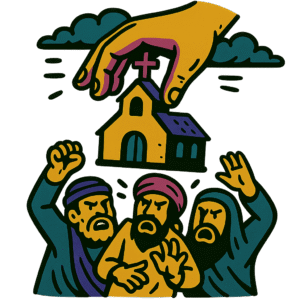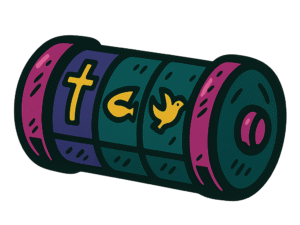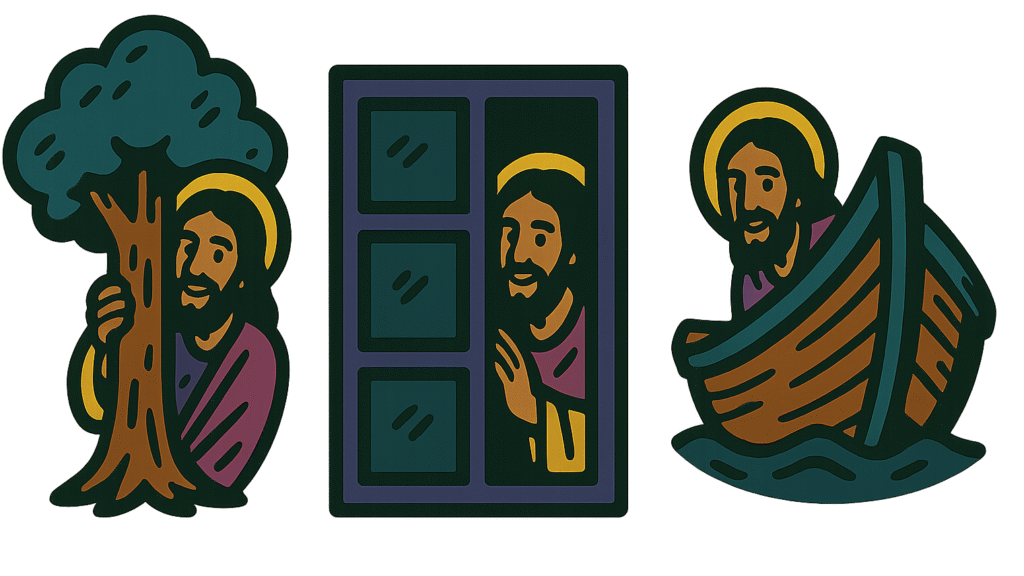In biblical interpretation, allegory is the practice of assigning symbolic or hidden meanings to people, events, or details in Scripture—sometimes beyond what the text itself or its inspired authors intended. While some allegories are explicitly sanctioned by Scripture, unsanctioned allegorical readings risk replacing the original, Spirit-inspired meaning with imaginative reinterpretations. This can subtly shift our focus from God’s intended message to ideas of our own making. Here are the seven most common subtypes of allegorical interpretation you might come across:
📚 1) Classical Allegory (The Four Meanings Approach)

Made prominent by Origen of Alexandria (c. 185 – c. 253) based on Platonic philosophy. This view says every Bible passage has multiple layers.
- A literal meaning (what actually happened)
- A hidden spiritual meaning (about God or salvation)
- A moral meaning (how we should behave)
- A future or heavenly meaning (about eternity)
🧾 Example
The story of Noah’s Ark is said to mean:
- Literal: A real flood happened.
- Spiritual: The ark represents Jesus, who saves us.
- Moral: We should obey God like Noah did.
- Future: The ark points to heaven where we’ll be safe forever.
⛓️💥 The problem
Most of those meanings are read into the story, not drawn from the actual text.
… Makes the Bible = a four-layered puzzle box that only experts can unlock

🧩 2) Typological Allegory
This approach looks for secret patterns in stories or objects and says they “represent” something spiritual—even if the Bible never says they do.
🧾 Example:
Some say David’s five stones (used to fight Goliath) represent five spiritual tools like faith, prayer, fasting, Scripture, and worship.
⛓️💥 The problem: The Bible doesn’t say that! It’s taking random details and forcing them to be symbolic without support. Types in scripture certainly exist, but assuming that every passage can be interpreted typologically risks making connections that were never to be made.
… Makes the Bible = a symbolic jigsaw puzzle

🌫 3) Mystical/Spiritual Allegory
This method treats the Bible like a spiritual codebook, claiming that the real message is hidden behind the words and can only be seen with deeper insight or personal revelation.
🧾 Example:
Some teach that the Song of Songs isn’t really about love between a man and woman—but a secret map for how to reach deep, mystical intimacy with God.
⛓️💥 The problem: It ignores the plain meaning of the book and turns the Bible into a spiritual puzzle.
… Makes the Bible = a gnostic codebook
🧠 4) Tropological/Moralistic Allegory
This is when people treat every story in the Bible like a self-help lesson or inspiration, rather than first asking what it meant historically or theologically.

🧾 Example:
They’ll say the story of David and Goliath is about “facing your fears” or “overcoming your problems.”
⛓️💥 The problem: It turns God’s story into our story—ignoring what it says about God’s plan and power. It also risks making passages therapeutic or psychologically prescriptive in ways that can be damaging. Certain books and passages within the Bible are helpful for defining a healthy psychology—like wisdom literature in the Proverbs or some epistolary writings in the New Testament—but it’s necessary to determine the genre of each book and passage before assuming a therapeutic application.
… Makes the Bible = a self-help manual or psychology textbook

🏛 5) Replacement Allegory
This method claims that when God talks to or about Israel, He’s really talking about the Church—and that Israel’s promises now belong to us spiritually.
🧾 Example:
In Ezekiel 37, God promises to bring Israel back from the dead like dry bones—but some teach this is about spiritual revival in the Church, not literal Israel.
⛓️💥 The problem: It changes the audience and meaning, and removes God’s promises to His people.
… Makes the Bible = a Church-centered prophecy rewrite or retcon, where Israel’s story is erased or overwritten
🔢 6) Symbolic/Numerological Allegory

This is when people take numbers, names, or objects and give them symbolic spiritual meanings—even if the text doesn’t suggest it.
🧾 Example:
Saying the number 7 in every story means “divine perfection,” or that Noah’s ark had three levels because we are body, soul, and spirit.”
⛓️💥 The problem: These meanings are often either made up or applied haphazardly, not revealed by God through Scripture. Hebrew numerology is present in a significant way in some places—like apocalyptic passages in John’s Revelation—but not every author is concerned with numbers in a symbolic sense, and some numbers are incidental.
… Makes the Bible = a spiritual cryptex or cipher
✝️ 7) Christological Allegory
This is when people force Jesus into every verse—even when the Bible doesn’t point to Him in that passage.
🧾 Example:
Saying the scarlet thread in Rahab’s window is a picture of Jesus’ blood covering our sins.
⛓️💥 The problem: While some passages do point to Jesus, many of them don’t. This approach overreads Jesus into every detail.

… Makes the Bible = a “Where’s Waldo?” game about Jesus
Allegory can feel creative and even inspiring, but when it overrides the plain sense of Scripture it leads us away from truth rather than toward it. Instead of reshaping the text to fit our imagination, let’s discipline ourselves to hear God’s Word as He gave it—seeking the author’s intent, trusting the Spirit’s guidance, and allowing Scripture itself to shape our understanding.
For more on the logical issues with allegorical interpretation, see The Problems of Allegorical Interpretation.


